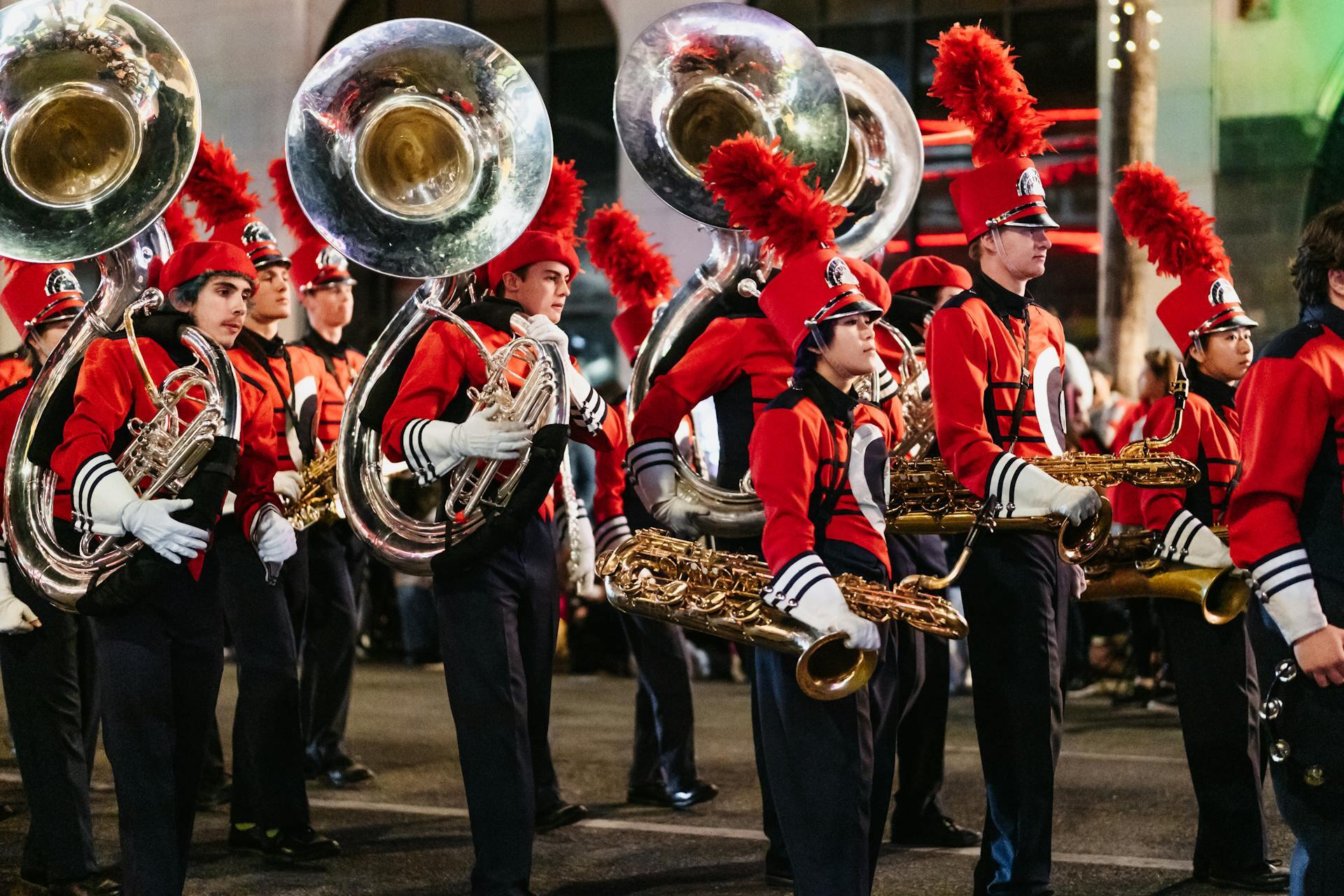Most marching band players get their first exposure to the artistic sport in elementary or middle school when they choose an instrument to play for the first time. But even students in high school or adults with no prior experience can still join! Discover the many different instruments found in marching bands, such as trumpets, snare drums, flutes, and cymbals, and what you need to know about playing them.

Factors to Consider in Choosing an Instrument
When weighing your options about what to learn for joining a marching band, you’ll need to consider a few key factors:
- Your previous or current experience playing any instrument
- Your experience with similar options
- Your ability to practice at home
- The level and type of athleticism you’re willing and able to have in the band
- The cost (if you are required to purchase or rent your own)
- Maintenance time and costs
- Can you comfortably carry it?
- Do you like the instrument and your role in the band?
In a high school band, you’re likely seated in one spot, reading sheet music as you perform in your concert recital. In a marching band, you will almost certainly need to memorize your part, since you’ll be walking, carrying your instrument, and moving choreographically in your performance!
To join, you will likely need to audition or at least show that you have some level of proficiency in reading music and performing.
Keeping that and all the other factors in mind, let’s cover the marching band instruments list and the main things to know about them, so you can make an informed choice!
Depending on the specific organization, they may contain any combination of instruments and sections.
The most common devices found are trumpets, tubas (sousaphones), clarinets, alto saxophones, snare drums, tenor drums, cymbals, and bells or glockenspiels.
Brass Instruments
This section is most notable for carrying the melodies and harmonies in the ensemble. In short, they’re the “voice” of the band, with the other sections acting as vital support for a fuller sound and aural experience. The high and low players work together to create a foundation for the other sections, with the middle brass rounding out the ensemble.
Trumpet
Trumpets are typically one of the most-featured instruments in this type of outift. They are one of the most prominent sounds in the ensemble. Their bright and brilliant brassy quality easily cuts through the other sounds for emphasis and flair.
Tuba, Sousaphone, or Contrabass Bugle (Contra)
The tuba is one of the most recognizable instruments, especially in a marching band.
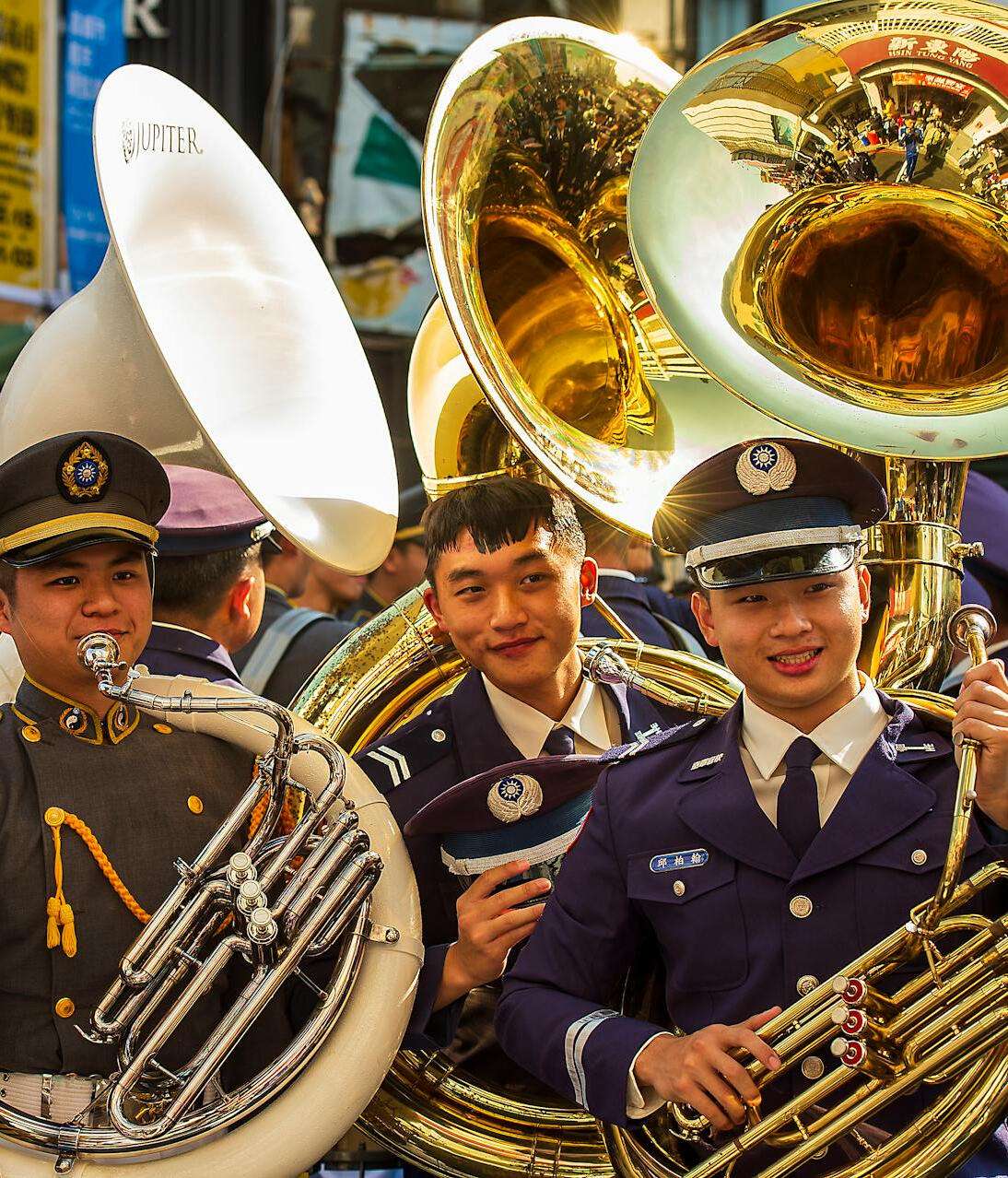
The traditional tuba is frequently replaced by its marching equivalent, the sousaphone, since it’s much easier to carry due to its hallmark wrap-around design.
The other tuba replacement commonly used is the contra, which sits on top of the shoulder.
Unlike the sousaphone, which coils around the musician, the contra is designed to rest across the shoulder like a massive trumpet.
In any case, the strong, low notes are a cornerstone of the melodic foundation in the composition.
Trombone
One of the most recognizable devices, the trombone’s unique slide mechanism makes it a unique experience. Most other winds rely on piston buttons and changing the valves inside to change notes; trombones require a different kind of muscle memory to hit the right notes. Their long slides make for a visually interesting addition, especially with synchronized, dramatic choreography!
French Horn or Mellophone
French horns are typically replaced by the marching equivalent, the mellophone. They look sort of like big trumpets and provide a smoother, mellow, mid-tone musicality. Their register fills out the bold orchestration in the brass section.
Some bands require these accessories, some only recommend them, and others may forbid them. Musicians can use accessories like lyres and flip folders, mouthpieces and tuning keys, carry hooks, level bars, and leg rests.
Other Inclusions
- Cornet
- Baritone horn
- Bugle
- Flugelhorn
- Euphonium
- Tenor horn
- Tenor trombone
- Bass trombone
Key Takeaways
- Requires athleticism for breath control while performing choreographed movements.
- Those who are smaller in stature or who are less strong will not be able to handle the larger options, like the sousaphone.
- Musicians must master breathing and breath exercises as well as embouchure techniques.
Pros
Consistently the loudest, boldest part of the ensemble.
Exercise and improved breath control are built into your practice.
Participate in some of the more expressive choreography.
Learning one instrument makes it easier to learn others.
Cons
They are very expensive and require lots of maintenance and care.
They are loud and not neighbor-friendly.
Heavier options can cause long-term back problems, especially if the player isn’t the right physical size or strength.
Without proper athletic conditioning and breath control, players may faint, especially on hot days.

Wind Instruments
The wind, specifically the woodwind section, is responsible for adding more texture and color to the overall melody. These options are perfect for short solo phrases and embellishments. The higher, lighter characteristics of the woodwind section help the entire wind section feel more well-rounded and filled out.
They cannot compete with the brass in terms of power and volume, so woodwinds are best used in a complementary, accompanying role.
The lowest voices in the woodwind section can be supplemented or replaced by the higher voices in the brass section, and vice versa.
Discover the rich history of marching bands!
Saxophone
The saxophone is a woodwind because it uses a reed in the mouthpiece to create a note. The most common saxophones in this musical outfit are the alto and tenor saxophones, but, depending on the band, there may be some other sizes present as well.
The large baritone and bass saxophones are rarely used because of their weight and delicacy. Instead, sousaphones can be used.
Flute and Piccolo
Both the flute and its smaller cousin, the piccolo, are lightweight, making them perfect to march with.
Because they require less physical exertion to carry and play compared to larger instruments, flautists and piccolo players can more easily perform for longer periods of time while also completing visually dazzling choreography.
Both are tuned to a higher register than all the other winds (the piccolo being the highest).
This unique tonal range allows them to cut through layers of brass and percussion, ensuring that the melody remains clear and audible.
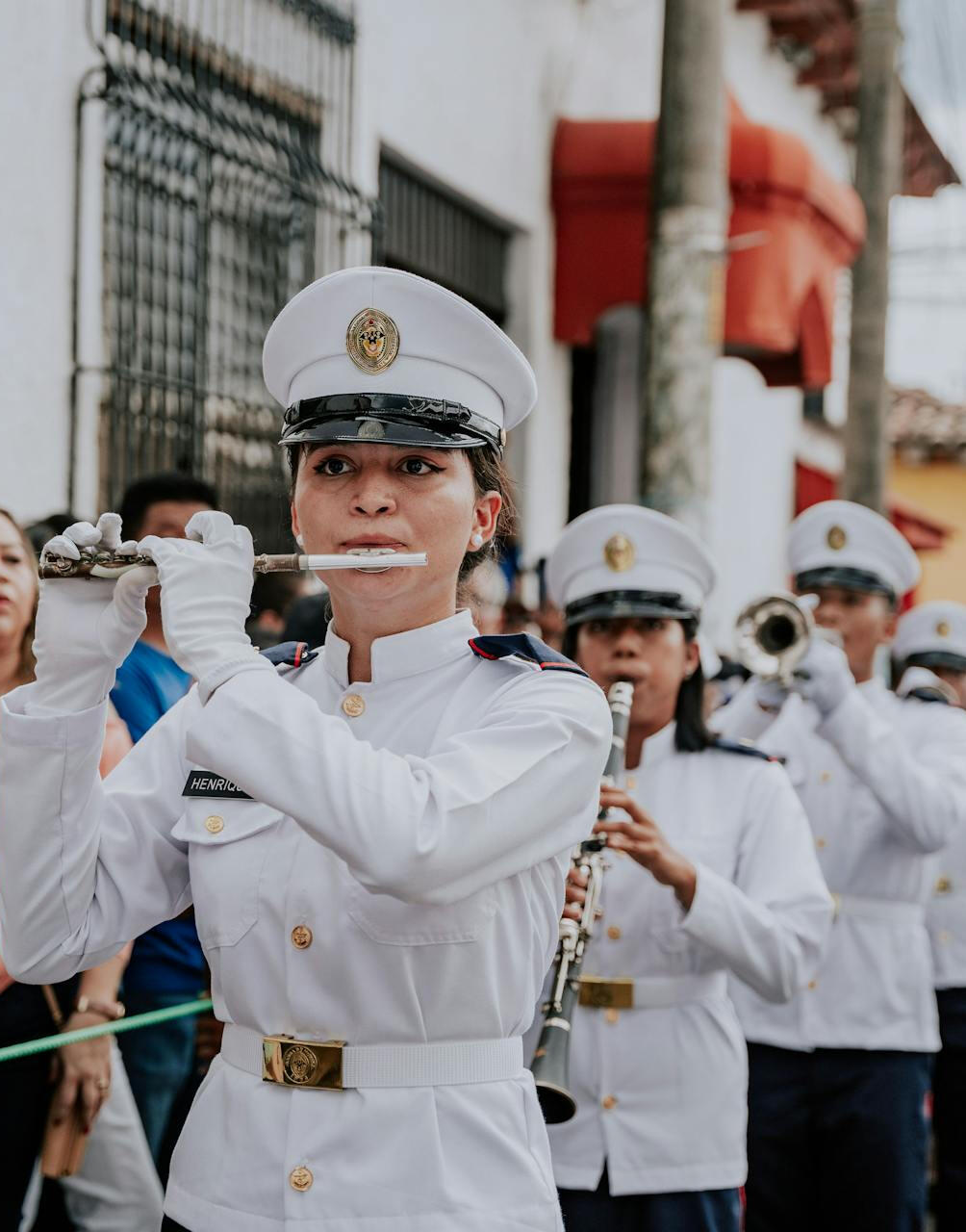
The flute’s warm yet bright timbre provides melodic grace, while the piccolo’s piercing voice is often used to add dramatic highlights.
Clarinet
The clarinet’s signature timbre and smooth quality make it a valuable addition in an ensemble. The versatile register of the clarinet makes it perfect for both melodies and harmonies, as well as group solos. In marching arrangements, the clarinet is often used to balance out the power of the brass section.
Other Inclusions
- Sopranino saxophone
- Soprano saxophone
- Baritone saxophone
- Bass saxophone
- Oboe
- Bassoon
- Bass clarinet
Key Takeaways
- Woodwinds are generally more accessible and less expensive (though still costly) and easier to handle physically.
- Requires proper breath control and embouchure techniques.
- Playing a woodwind gives you more opportunities for interesting parts in the musical arrangement, including solos, group solos, and melody and harmony support.
- The diffuse nature requires strict synchronized intonation to be properly heard when performing melody and harmony.
Pros
More opportunities for individual and group solos and flourishes.
Lightweight woodwinds are easier to carry and use for a longer time with less fatigue compared to brass options.
Improve your breath control during practice, which can even help in daily life.
Learning one woodwind means it's easier to learn others.
Cons
They are typically quite expensive and require lots of maintenance and care.
It’s easy to accidentally damage them, which is a heightened risk during choreography or bad weather.
Humidity and temperature can contribute to tuning problems.
Heavier options may contribute to long-term injury, like back problems, if the player is not well-conditioned.
Percussion Instruments
The percussion section is perhaps the most iconic part! The percussion section is vital for keeping time and rhythm, both for the music and for the choreography.
Percussion adds a layer of pizzazz, energy, and impact to any performance. Since they’re used throughout the entirety of an arrangement, they are like the glue holding the whole assembly together.
Tenor Drum
The tenor drum (aka quads or quints) is typically an arrangement made up of four or five small drums (hence the nicknames) of different notes. Some assemblies will also have one or two “special effect” drums called “spocks” that are used for embellishments.
Tenor drum players typically accompany the melodies and harmonies of the other sections, with divergences for flair added in.
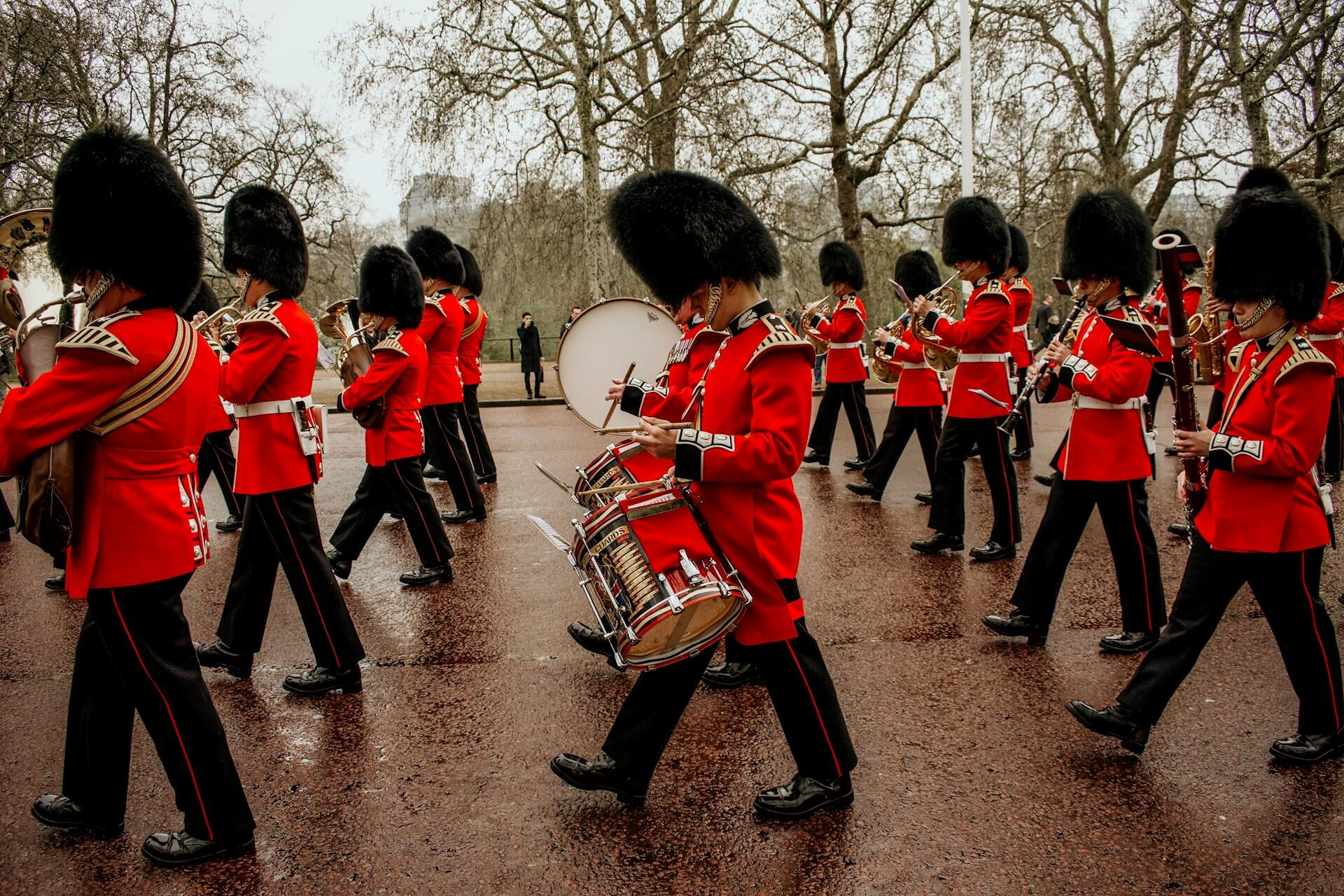
Snare Drum
One of the most recognizable sights in the drumline, the snare has the job of providing monotone accents with precision. They may supply one or a handful of strikes as flair and beat-keeping, or perform a drumroll to increase the anticipation and energy. A snare sounds like rapid-fire attacks, adding exciting tension to the composition's overall sound.
Bass Drum
The large, iconic, sideways drum, allows the player to hit both sides rather than just one. The deep, resonant beats can be heard and felt beneath all the other notes, helping the entire outfit stay in time even over long distances.
Bass drums come in several sizes, and the larger options can be quite heavy. An assembly will typically try to have at least one that is the lowest register possible for the drum player who can physically handle a heavy, massive drum.
Glockenspiel, Xylophone, Vibraphone, or Marimba
Mallet percussion instruments bring a distinctive character to a marching band's soundscape.
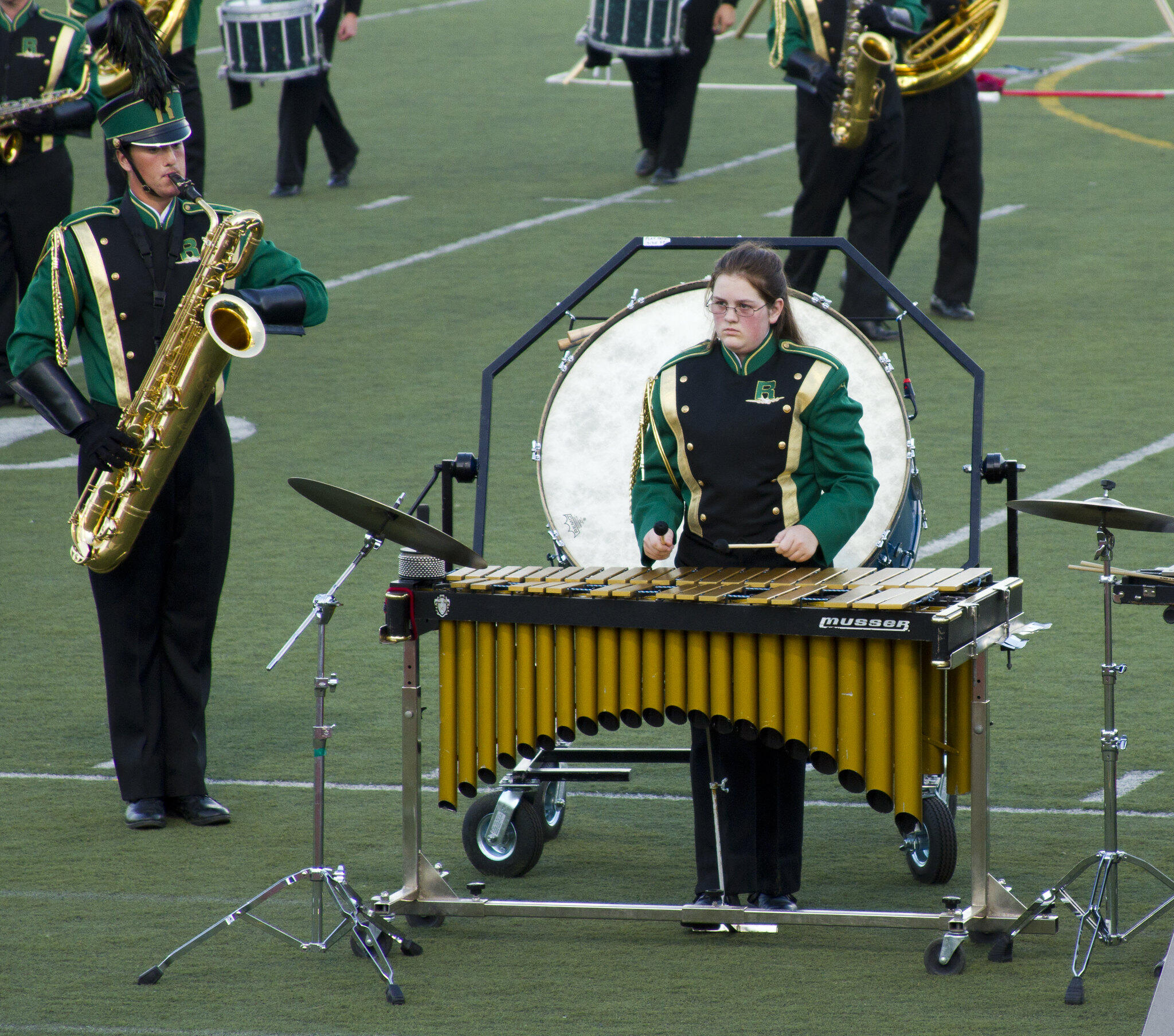
Located either within the battery or in the front ensemble, these mallet percussion instruments add higher-pitched musical percussive tones to the arrangement.
These instruments combine rhythmic precision with melodic clarity.
Unlike drums that focus purely on rhythm, mallet percussion produces definite pitches.
In this way, they serve as a bridge between melody and rhythm.
Their musical quality can be like a sparkle decorating the melodies and harmonies. These options add color and brightness in a different way than woodwinds.
Cymbals
You can’t have the iconic marching band without cymbals! Players hold one in each hand and crash them together to create loud short or long notes. The clash is used as a flourish, embellishment, or accent. They also help keep the rhythm along with the other players.
Other Inclusions
- Timpani drum
- Marimba
- Bell-lyre
- Vibraphone
- Chimes (tubular bells)
- Turkish crescent
Key Takeaways
- Drummers often recognize that they will suffer from injuries like tendinitis and back pain, but participate anyway for the love of the art.
- Smaller options are accessible for many players, but the large bass drums are only suitable for larger, stronger players.
- Many battery players find drumming to be really fun, which is part of why they joined a marching band.
Pros
No breath control required! The act of drumming is easier on the body.
Drums are the easiest to practice, since you can use drum pads at home without disturbing your family or neighbors.
Ensure the hype and energy are heightened for both your fellow bandmates and the audience.
Cons
Heavy drums, improper conditioning, or improper support can cause pain and long-term injury.
Larger options are typically not portable and are very expensive, so they can only be practiced with the group, not on your own.
Maneuvering with the bass is especially difficult since you can’t see in front of yourself.
Auxiliary Instruments
Some organizations outfit themselves with literal bells and whistles (among other things) to create an even more incredible musical experience. These apparatuses typically only appear in performances in one place, like at a football halftime show, for example, as opposed to a parade.
They are usually part of the front ensemble, and often there will be one or two players who handle a handful used as accent pieces.
The job of the auxiliary section is to back up the main ensemble as well as add embellishments to the piece as needed.
The front ensemble (aka pit) consists of non-portable apparatuses that are too large to be carried. In a show, they tend to be located at the front (hence the name) in a stage-like arrangement. In a parade, they might be stationed on a float, but they may be omitted from the ensemble for safety and logistics reasons.
Strings
Though uncommon, some outfits include electric guitars or electric bass guitars in their ensemble. Guitars typically play in the pit, since they require amps to be heard over the cacophony of all the other, far louder, instruments. If you want to join a marching band, but don’t want to learn the standard options, you might be able to ask your band director about adding a guitar to the ensemble.
Percussion
Most of the auxiliary options in any band are typically percussive in nature. They will also be located in the pit and typically amplified in order to be heard. They’ll also typically only be used a few times in a piece for flair.
The most common auxiliary instruments are:
- Tambourines
- Shakers
- Woodblocks
- Castanets
- Triangles
- Brake drums
- Gongs
- Windchimes
- Drum set
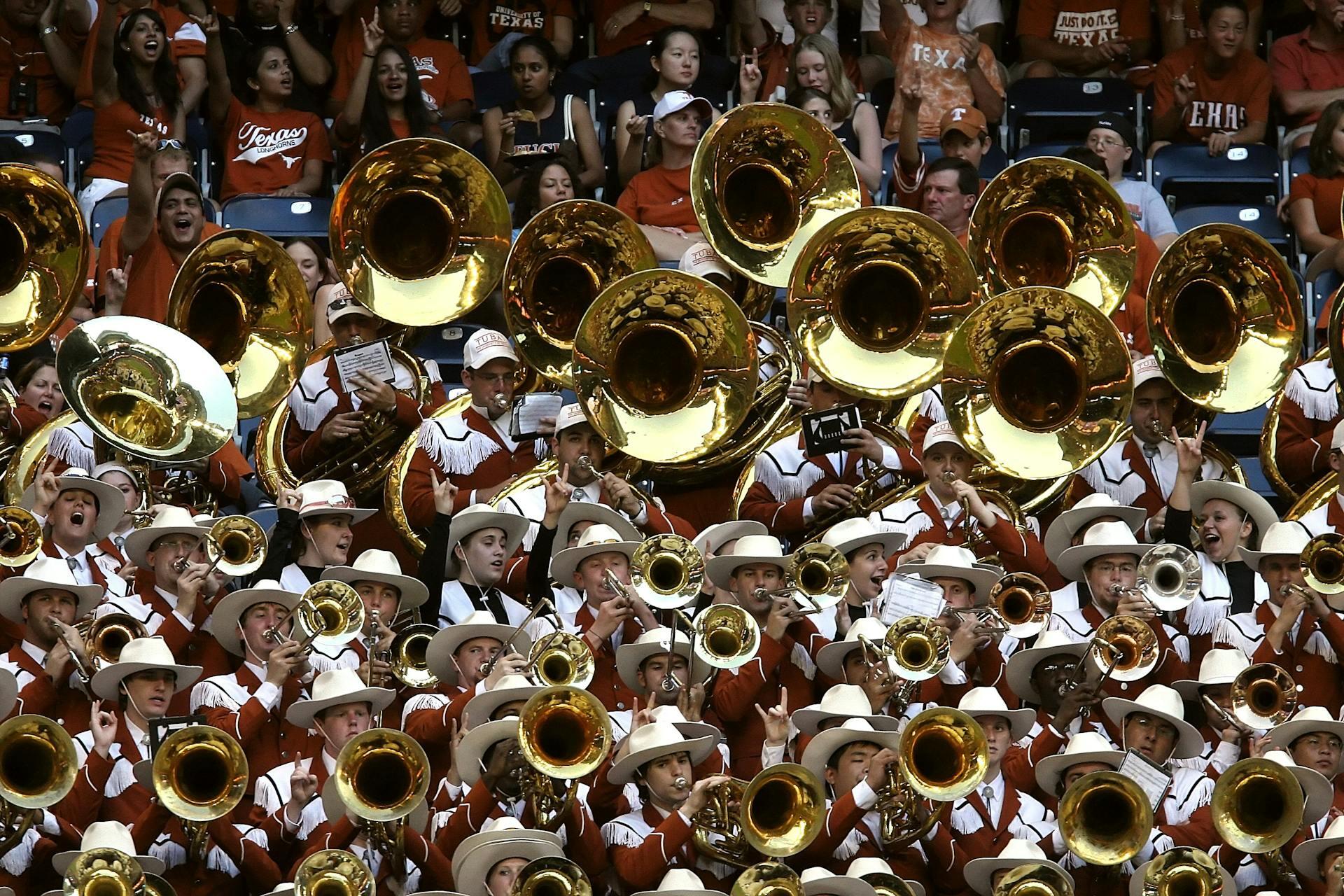
Pros
Playing different kinds of options in the same performance can be fun!
If you're not fond of marching, these options generally stay in the front ensemble only.
Cons
Some auxiliary musicians feel like their bandmates or conductors don't take them as seriously as the other musicians.
On the other hand, if you wanted to march, you won't be able to.
Selecting an instrument is a big choice, but it’s meant to be fun! If you’re in middle or high school, you can likely rent or borrow it from the music department. You may be able to try out several different options in your tenure.
If you're an adult or a college student interested in doing a band, you will likely need to supply your own instrument, which can be quite pricey. But if you search around for beginner-friendly bands, you might find some that have alternative options.
No matter what age you are, you might need to audition for a place in the band. If that’s the case, you can quickly learn enough to pass your audition with the help of a professional private music tutor! Search on Superprof today for help learning any instrument you’re interested in. Your tutor can help you prepare for auditions, improve your abilities, and perfect your techniques.

